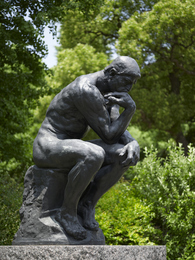Auguste Rodin
Paris, 1840 - Meudon, 1917
考える人(拡大作) The Thinker (Enlarged)
| 制作年 | 1881-82年(原型)、1902-03年(拡大)、1926年(鋳造) |
|---|---|
| 材質・技法・形状 | ブロンズ |
| 寸法(cm) | 186 x 102 x 144 |
| 署名・年記 | 台座右側面に署名: A. Rodin; 台座背面右下に鋳造銘: Alexis Rudier / Fondeur Paris |
| 所蔵経緯 | 松方コレクション |
| Standard ref. | M1288 |
| 分類 | 彫刻 |
| 所蔵番号 | S.1959-0040 |
《考える人》について、ロダンは次のように述べている。「扉の前でダンテが岩の上に腰を下ろし、詩想に耽っている。彼の背後には、ウゴリーノ、フランチェスカ、パオロなど『神曲』のすべての人物たち。この計画は実現されなかった。全体から切り離された痩身の苦悶するダンテの姿は、意味がなかった。私は最初のインスピレーションに従って別の思索する人物を考えた。裸の男で岩の上に坐り、両足を引き寄せ拳を歯にあてて、彼は夢想している。実り豊かな思索が彼の頭脳の中でゆっくりと確かなものになってゆく。彼はもはや夢想家ではない。彼は創造者である」。《考える人》の肉体表現とその姿勢には、《アダム》と同様にミケランジェロの影響が感じられる。システィーナ礼拝堂天井画の預言者エレミア、サン・ロレンツォ聖堂メディチ家墓廟のロレンツォ・デ・メディチなどである。しかし、更に直接的な影響を及ぼした作品はカルポーの《ウゴリーノ》(1863年)である。右肘を左の腿に置いた姿勢は、驚くほどよく似ている。しかし、このカルポーの彫刻がミケランジェロの影響下にローマで制作されたことも事実である。このブロンズの巨像は、1902年から1903年にかけて、ロダンの良き協力者であったアンリ・ルボセの手によって1881–82年の原型に基づいて拡大された。《地獄の門》から独立した《考える人》は、一個の思索する人物ではなく人類共通の普遍的な人間像となった。(出典: 国立西洋美術館名作選. 東京, 国立西洋美術館, 2009. cat. no. 133)
来歴
松方幸次郎氏購入; 1944年フランス政府が接収; 1959年フランス政府より寄贈返還
展覧会歴
- 1966
- ロダン展: 没後50年記念, 国立西洋美術館, 1966年7月23日-1966年9月11日, cat. no. 18
- 1989
- ロダン「地獄の門」展: 開館30周年記念展, 国立西洋美術館, 1989年10月21日-1989年12月17日, cat. no. 7
文献歴
- 1990
- 神戸市立博物館編. 松方コレクション西洋美術総目録. 神戸, 「松方コレクション展」実行委員会, 1990, cat. no. S-54.
- 2006
- 国立西洋美術館名作選. 東京, 国立西洋美術館; 東京, 西洋美術振興財団, 2006, no. 133, repr.
- 2009
- Masterpieces of The National Museum of Western Art, Tokyo. Tokyo, The National Museum of Western Art; Tokyo, The Western Art Foundation, 2009, no. 133, repr.
- 2013
- 国立西洋美術館名作選. 東京, 西洋美術振興財団, 2013, no. 132, col. repr.
- 2019
- 松方コレクション:西洋美術全作品. 川口雅子; 陳岡めぐみ編. 第2巻 彫刻・素描・版画・工芸その他, 東京, 国立西洋美術館, 2019, cat. no. 1288, col. repr.
The Thinker (Enlarged)
| Date | 1881-82 (model), 1902-03 (enlarged), 1926 (cast) |
|---|---|
| Materials and Techniques | bronze |
| Size(cm) | 186 x 102 x 144 |
| Inscriptions | Signed right side of base: A. Rodin; Foundry mark lower right back of base: Alexis Rudier / Fondeur Paris |
| Credit Line | Matsukata Collection |
| Standard ref. | M1288 |
| Category | Sculptures |
| Collection Number | S.1959-0040 |
Rodin made the following comment about The Thinker. "Dante sat down on the rock in front of the gates and became absorbed in poetic reverie. Behind him were Ugolino, Francesca, Paolo and all the other characters of the Divine Comedy. This plan was never realized. The anguished form of Dante's thin body isolated from the whole was meaningless. Following my initial inspiration, I then thought of another pensive figure. A naked man sits lost in thought on a rock, with both legs drawn up and his fist resting against his teeth. The work inspires a slow consideration of the beautiful thoughts that fill his head. He is not an idle dreamer. Rather, he is a creator."The physical expression and form of The Thinker, like Adam's, reveal the influence of Michelangelo. Figures such as the prophet Jeremiah in the Sistine Chapel ceiling frescos, and Lorenzo de Medici on the Medici tomb in San Lorenzo Chapel come to mind. Another work that exerted a direct influence was Carpeaux's Ugolino (1863). The image of the right elbow resting on the left thigh is surprisingly similar to Carpeaux's work. The work by Carpeaux, however, was actually executed in Rome under the direct influence of Michelangelo.This gigantic bronze figure was enlarged between 1902-04 by Rodin's collaborator Henri Lebossé on the basis of Rodin's model from 1880. The Thinker, set apart from The Gates of Hell, does not depict an individual thinking figure, but rather represents a universal image of mankind. (Source: Masterpieces of the National Museum of Western Art, Tokyo, 2009, cat. no. 133)
Provenance
Bought from Musée Rodin by Kojiro Matsukata, Kobe through Léonce Bénédite, ca. August 1919, as ‘Le Penseur, taille colossale’ (Fr. 50,000) [see several letters between Bénédite and Suzuki & Co., August 1919, in Archives of Rodin Museum, Paris; copy in NMWA curatorial files]; sequestered by French government, 1944; vested in French government under San Francisco Peace Treaty, 1952; transferred from French to Japanese government, 23 January 1959; entered into NMWA, April 1959.
Exhibition History
- 1966
- Rodin, National Museum of Western Art, Tokyo, 23 July 1966 - 11 September 1966, cat. no. 18
- 1989
- Rodin et la Porte de l’Enfer (Rodin and the Gates of Hell), National Museum of Western Art, Tokyo, 21 October 1989 - 17 December 1989, cat. no. 7
Bibliography
- 1990
- The Old Matsukata Collection. Kobe City Museum, ed. Kobe, "Matsukata Korekushon Ten" Jikkoiinkai, 1990, cat. no. S-54.
- 2006
- Masterpieces of The National Museum of Western Art, Tokyo. Tokyo, The National Museum of Western Art; Tokyo, The Western Art Foundation, 2006 (Japanese, preface in Japanese and English), no. 133, repr.
- 2009
- Masterpieces of The National Museum of Western Art, Tokyo. Tokyo, The National Museum of Western Art; Tokyo, The Western Art Foundation, 2009, no. 133, repr.
- 2013
- Masterpieces: The National Museum of Western Art, Tokyo. Tokyo, The Western Art Foundation, 2013 (Japanese, preface in Japanese and English), no. 132, col. repr.
- 2019
- The Matsukata Collection: Complete Catalogue of the European Art. Kawaguchi, Masako; Jingaoka, Megumi, eds. vol. 2: Sculpture, Drawings, Prints and Decorative Arts and Other Works, Tokyo, The National Museum of Western Art, Tokyo, 2019, cat. no. 1288, col. repr.



































